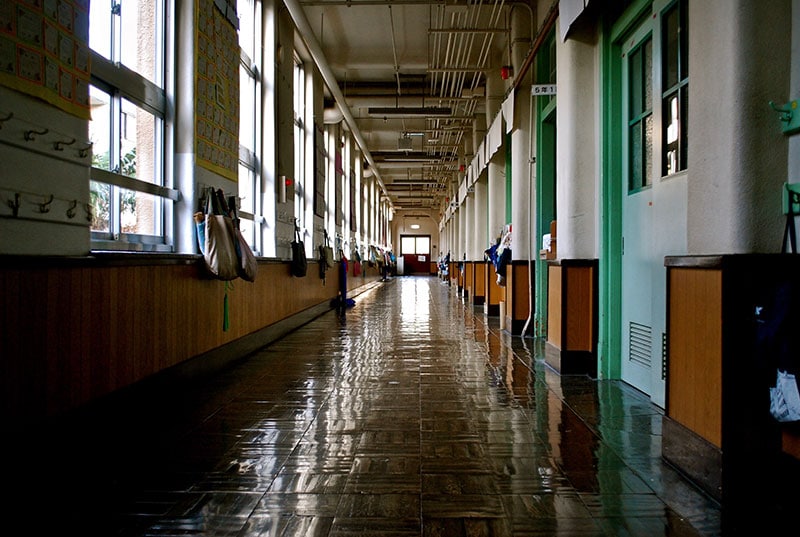Where will I find asbestos in a school?
For many people today – and certainly great numbers of today’s parents – it might seem difficult to believe that asbestos was once a widely trusted, go-to building material. Today, the naturally occurring mineral is synonymous with serious risks to health. For much of the 20th century, however, it was a substance that seemed to be used in almost any and every building product.
Indeed, such was the popularity and widespread use of asbestos in the construction of schools, that to this day, it is believed that most school and college buildings in the UK still contain asbestos.
Only in late 1999 were all forms of asbestos finally banned in the UK. What this means is that while asbestos should not be present in any school buildings constructed after the year 2000, in the case of such structures built prior to the year 2000, there is a strong chance of asbestos being present.

Photo by kyo azuma
Why was asbestos used in schools and what was it used for?
Asbestos was used in many different building products during the 20th century, due to its relative affordability, availability, strength, and fire resistance. The material was used in such products as spray coatings, insulation lagging, insulation boards, and asbestos cement products such as wall and ceiling panels, corrugated roof panels, tiles, pipes, and gutters.
As time wore on, however – and especially by the 1970s and 1980s – public awareness was growing of a link between asbestos exposure and perilous risks to health. It was discovered that when someone breathed in or ingested asbestos such as that found in schools up and down the UK, they ran the risk of developing any of a range of serious and often fatal health conditions, such as mesothelioma, asbestosis, and asbestos-related lung cancer.
These diseases don’t begin to show symptoms straight away. Indeed, it often many decades for an asbestos-related health condition to become apparent in the sufferer, following their initial exposure to asbestos.
This long latency period for asbestos-related disease is another factor that may have meant it took a while for many people to become fully aware of the serious risk the substance posed to human health.
Where can asbestos be found in schools?
As aforementioned, it is school buildings that date from before the year 2000 that are of concern as far as the historical use of asbestos is concerned. Asbestos-containing materials (ACMs) can potentially be found in an exceedingly broad range of building products within a school, such as:
- Ceiling tiles
- Vinyl flooring (including backing and glue)
- Wallboard
- Duct work for heating and cooling systems
- Pipe wrap insulation
- Boiler insulation
- Cement sheets
- Textured paint or “popcorn” ceilings
The Department for Education (DfE) has long published guidance on how decision-makers such as school leaders, governors, local authorities, and academy trusts can safely and effectively manage ACMs that might be present in their buildings.
When does asbestos in schools become a risk to health?
The good news is that the mere presence of asbestos in a school, in and of itself, is not considered sufficient to pose a major health risk. Provided that any given ACMs are in good condition and are left undisturbed, it is not thought likely that they will present a health risk in the future.
However, in the event that such ACMs are disturbed, this can easily cause asbestos fibres to be released into the air. This, in turn, can present a high level of risk to someone nearby who may ingest or inhale the fibres. Indeed, with asbestos fibres not being visible to the naked eye, someone may disturb and be exposed to the substance without even knowing that this has happened.
So, if you have what is known as the “duty to manage” asbestos in your school – as set out by the Control of Asbestos Regulations 2012 (CAR 2012) – you will need to be alert to the scenarios in which asbestos could be disturbed and therefore become a risk to health.
One of the most obvious situations in which asbestos could pose a health risk in a school, is when maintenance, repair, and/or construction work is taking place on the premises. This is because such disruptive work could cause asbestos to be disturbed that on-site workers might not have even realised was present. For this reason, CAR 2012 sets out that a dutyholder must provide information about on-site ACMs to anyone who will be liable to work on or disturb such materials.
Who is at risk from asbestos in schools?
As aforementioned, it is maintenance, repair, and/or construction activities on a school site that are especially likely to disturb any asbestos materials that may be on the premises.
School caretakers could therefore be at particularly high risk of coming into contact with asbestos, due to the nature of their work, which can include drilling and fixing. For similar reasons, any contractors who you arrange to have on-site to carry out maintenance or installation work could also be at an elevated level of risk.
However, any given school is effectively one community. So, it is crucial to appreciate that even if someone in one of the above categories is the person who actually disturbs the ACMs, the consequent release of asbestos fibres could then pose a risk to others using the school buildings.
Fortunately, the UK Health and Safety Executive (HSE) has said that teachers and pupils are unlikely to be at risk of asbestos exposure “in the course of their normal activities”.
This presumes, however, that any asbestos on-site is in good condition, and is not in a location that makes disturbance likely. Furthermore, the dutyholder must properly manage any such materials in accordance with CAR 2012.
In addition, the HSE states that teachers and pupils should avoid undertaking activities that are known to damage ACMs, such as pinning or tacking work to insulation board or ceiling tiles.
How can schools manage the problem?
There are various steps that dutyholders can – and must – take in order to manage the asbestos that might be present in their school buildings.
If asbestos is found in a school, knowing the exact steps to take for your school will depend partly on whether certain materials on the premises are confirmed to be asbestos, or merely suspected to be asbestos. You will also need to determine whether an asbestos management plan is already in place for the school building in question, and whether certain asbestos surveys or testing will be needed in order to ascertain the true status of asbestos on the site.
As a dutyholder for a school under CAR 2012, you should be looking at such measures as the following:
- School asbestos surveys If you suspect that asbestos is present on your school site, you should determine when the last asbestos survey was carried out, and what asbestos management plans – if any – have previously been put in place.Any existing asbestos management plan for your school premises should set out what steps will be taken to manage previously identified asbestos on the site.It might turn out that you need to have a new asbestos survey undertaken in your school buildings, with a reputable and UKAS-accredited company taking away samples for laboratory analysis.
- The creation of an asbestos management plan It may be necessary for you to assemble an asbestos management plan for your school premises, in the event that there isn’t such a plan in place already. Alternatively, you might need to update an existing plan, or to arrange an asbestos reinspection survey.The HSE has stated that all schools require a site-specific asbestos management plan. It is a document of critical importance, given that it will set out the approaches you intend to take in order to manage asbestos within the property in question. The asbestos management plan will also need to make clear how you will protect site users from the risk of asbestos exposure.Whatever your school’s asbestos management plan ultimately looks like, it will need to be clear, simple, and easy to access. You will also need to regularly review this document.
- Determining whether to manage or remove the asbestos Despite the risks of asbestos as we have made clear throughout this article, it won’t necessarily be an automatic decision to remove any asbestos that you do find to be present on your school site.However, while it is sometimes possible to manage asbestos by leaving it in place, there are certain circumstances in which you might decide to remove the asbestos instead. This may be the case in the event of the on-site asbestos being disturbed, or if the ACMs are in a location that would mean a high likelihood of future disturbance.With asbestos being a notoriously dangerous substance, if you do favour the idea of removing the material from your school site instead of managing it, we would urge you to get in touch with professional asbestos consultants for advice and guidance.
- Asbestos awareness training Both school staff and contractors using the site will benefit from receiving a good level of asbestos awareness training.Whenever you arrange to have a contractor carry out work on your school premises, you should always check that they have received extensive asbestos awareness training. This will help the contractor to avoid disturbing any on-site ACMs. Although asbestos awareness training isn’t a legal requirement for tradespeople, it is strongly recommended that they complete such a course.Don’t forget to book in your school caretaker for asbestos awareness training, too. As we explained above, caretakers can be at particular risk of coming into contact with asbestos. So, the right training will help them ensure they undertake simple maintenance and repair jobs around the school, at the same time as applying proven safety measures and precautions.
- Reviewing and monitoring the asbestos If you do decide to leave ACMs in place at your school site, you will still need to keep an eye on those materials over time, to help ensure the highest possible levels of safety.When we say “keep an eye on”, we are referring to carrying out visual inspections of the identified materials, and checking for any signs of damage.If there are no visible indicators of damage to the ACMs – such as visible debris, dust, or asbestos material that seems to be in poor condition – the HSE states that the potential for release, spread, and exposure to the asbestos fibres is “extremely low”.
Would you like to learn more about Oracle Solutions’ wide-ranging asbestos services, including those that could greatly assist you in the management of asbestos on your school premises? If so, please do not hesitate to contact us by email for a quote, or by calling Oracle Solutions today.

Written by Jess Scott
Jess Scott has been an all-round asbestos consultant since 1996. That’s nearly 3 decades of asbestos knowledge. He spends his time sharing that knowledge with the team at Oracle and with their clients. Jess's goal is, and always has been, to use my expertise in helping people to comply with the law. This legal compliance ultimately helps to protect everyone from the harmful effects of asbestos. Jess has acted as an asbestos expert witness in legal cases and is involved in many asbestos educational activities throughout the UK.
